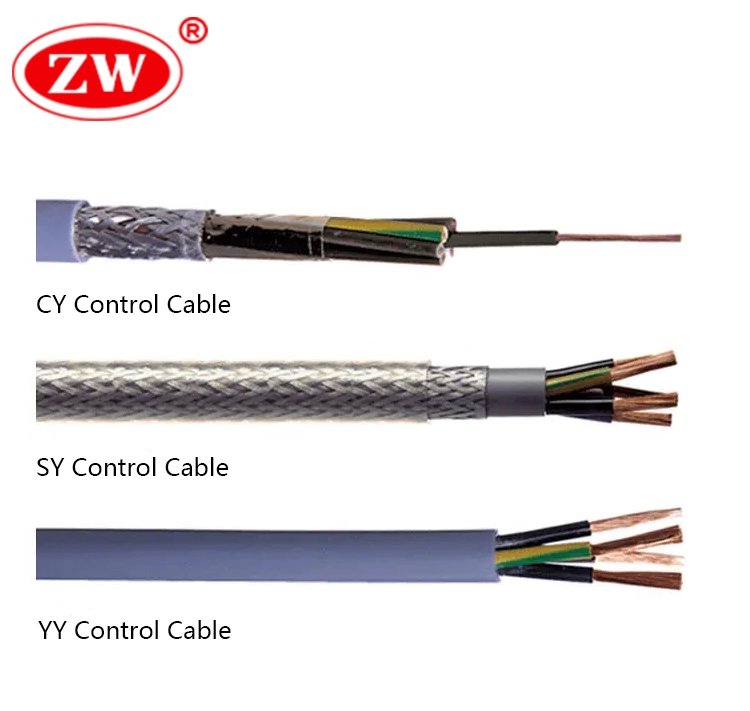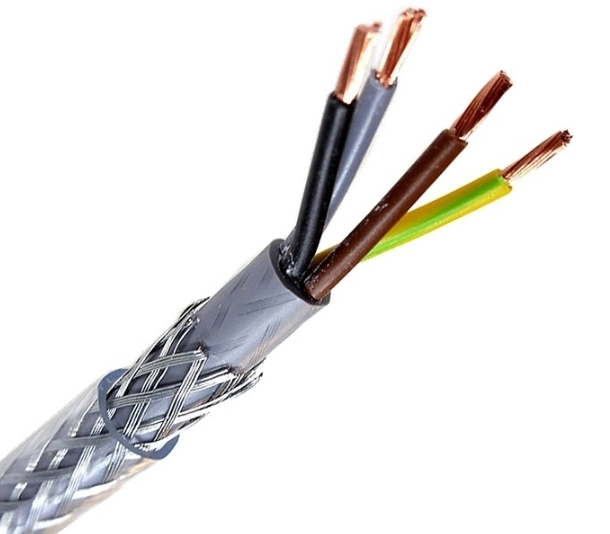Imagine when we give instructions in an automation system, how can we ensure that the information is accurately executed? In which the most critical transmission component is the control cable. Control cables are multi-core cables for automation and instrumentation applications that measure and regulate the transmission of automated processes.
Why control cable is so vital? This article will detail the specifications, types, sizes, and colors of controlling cables and how they differ from electrical cables.

What is control cable?
Control electrical cable is a type of flexible mechanical cable used to relay control signals or forces from the system to the specific control point; which are commonly used in various applications requiring precise control and manipulation, such as industrial automation, robots, and CNC machine tools. In consideration of precise control and downtime costs, the requirements for electrical control cables are more stringent than other types of cables, which need to be characterized by stable transmission and strong resistance to electromagnetic interference. For this reason, control wires are made up of multi-stranded or single copper conductors insulated with PVC or low smoke zero halogen (LSZH), and some sizes of cables are shielded with braided copper wire to minimize interference.
nothing found.

Control wires play a vital role in regulating processes, ensuring the proper functioning of machinery, and maintaining communication between control devices and sensors. Known for their reliability, and flexibility, they can operate at temperatures up to 80℃. And depending on the specific application, there are different variants of control wires to suit different requirements, such as push-pull control cables for vehicle throttle control (throttle control cable), and access control cables for security access control systems.

Below we talk specifically about the most common types summarized from the controlling cable variants.
What are control cable types?
Understanding the types of control wires is critical to choosing the right one for the given task. The most common types are:
CY Cable: CY cables are shielded flexible cables. They feature a tinned copper braid shield around the cable core to provide protection against electromagnetic interference (EMI) and radio frequency interference (RFI), commonly used for interference-free transmission, maintaining signal integrity.
SY Cable: SY cables are flexible control electrical cables, similar to CY cables, but containing galvanized steel braided for mechanical protection and adopting a transparent PVC sheath for easy viewing of internal wear or damage. Typically applications contain garden lighting, pond pumps, and other applications where resistance to high levels of stress without a loss of flexibility is required.
YY Cable: YY cables are unshielded flexible controlling cables. They do not have shielding for protection but are cost-effective and versatile. YY cables are used in general-purpose applications where EMI/RFI interference is not a concern, such as control panels, instrumentation, and lighting systems.

Whether you need to control machinery, transmit electronic signals, or for the reliable operation of vehicles, choosing the right type is a priority. Moreover, the size of the control electrical wire is also a pivotal element in determining whether the application can be operated safely or not.
Control cable size chart.
Below is a multi-core cable application diagram. Since control cable single core is not as common as multi-core cables, this table starts with 2 core control cable:
| Multi-core Control Cable Size Chart | |||
|---|---|---|---|
| Specification | Cross-section Area (mm²) | No. Of Core | Application |
| KVV (Solid Copper Conductor,PVC Insulation,PVC Sheath) | 0.75 1.0 1.5 2.5 | 2-16 | Commonly used for general-purpose electrical wiring in fixed installations, such as in buildings, industrial plants, and power distribution systems. |
| 4 6 | 2-14 | ||
| 10 | 2-10 | ||
| KVVP (Solid Copper Conductor,PVC Insulation,Braiding Shielded ,PVC Sheath) | 0.75 1.0 1.5 2.5 | 2-61 | Suitable for applications requiring electromagnetic interference (EMI) protection |
| 4 6 | 2-14 | ||
| 10 | 2-10 | ||
| KVVP2 (Solid Copper Conductor,PVC Insulation,Copper Tape ,PVC Sheath) | 0.75 1.0 1.5 2.5 | 4-10 | Can be used in environments like data centers and industrial automation systems. |
| 4 6 | 7-61 | ||
| 10 | 4-10 | ||
| KVV22 (Solid Copper Conductor,PVC Insulation, Armoured ,PVC Sheath) | 0.75 1.0 1.5 2.5 | 7-61 | Can be used where mechanical protection is needed, such as direct burial, underground conduits, or locations prone to physical damage. |
| 4 6 | 4-14 | ||
| 10 | 4-14 | ||
| KVVR (Stranded Copper Conductor,PVC Insulation,PVC Sheath) | 0.5 - 0.25 | 4-61 | Their stranded conductors are flexible and suitable for applications requiring frequent bending and movement, such as control and instrumentation systems. |
| KVVRP (Stranded Copper Conductor,Braiding Shielded, PVC Insulation,PVC Sheath) | 0.5 0.75 1.0 | 4-61 | |
| 1.5 2.5 | 4-48 | Combines flexibility and EMI protection for dynamic applications such as robotics and machinery. | |
| KYJV (Solid Copper Conductor,XLPE Insulation,PVC Sheath) | 0.75 1.0 1.5 2.5 | 2-16 | |
| 4 6 | 2-14 | For applications requiring higher operating temperatures and better resistance to environmental factors. | |
| 10 | 2-10 | ||
| KYJVP (Solid Copper Conductor,XLPE Insulation,Braiding Shielded, PVC Sheath) | 0.75 1.0 1.5 2.5 | 2-61 | Can be used in environments where electromagnetic interference is a problem and offer the benefits of XLPE insulation, making them suitable for industrial control systems. |
| 4 6 | 2-14 | ||
| 10 | 2-10 | ||
| KYJV22 (Solid Copper Conductor,XLPE Insulation, Armoured, PVC Sheath) | 0.75 1.0 1.5 2.5 | 7-61 | Provides both mechanical protection and enhanced environmental resistance, making it suitable for outdoor and harsh industrial environments. |
| 4 6 | 4-14 | ||
| 10 | 4-10 |
The chart above can be used as an application guide to help you understand the control cable specifications more intuitively. In addition, though control electrical wires are often used in cooperation with electrical cables, it is necessary to distinguish between them.
What is the difference between control cable and power cable?
Control wires and electrical cables are both essential components of electrical systems and play a vital role in various devices’ operations. They are differentiated by:
Function, Ratings & Flexibility:
- Function (Key difference): Electrical cable transmits and distributes energy from the source to equipment, while controlling cables send low-voltage signals to control device operation.
- Rated Voltage: Electrical power cables can be categorized into HV, MV, and LV, with high voltage up to 110kv. In contrast, the control wire has a voltage range of 450/750V.
- Flexibility: Thicker insulation makes power cables typically less flexible and less resistant to frequent bending or movement than control wires.
Appearance & Structure:
- Size: Electrical cables normally come in larger sizes (up to several hundred square meters)due to the high currents they carry, whereas control wires are smaller, with a maximum cross-sectional area of 10 mm².
- Number of cores: Electrical cables have fewer cores, usually single or three cores, up to 5 cores. In contrast, control wires have a large number of cores, such as 12-core cables and 8-core cables, with up to 60 cores.
- Insulation: Control wires are insulated with PVC, while electrical wires are insulated with XLPE.
- Sheath: In the case of the same specification, such as a 3*4mm2 cable, the sheath thickness of electrical cable is thicker than that of control cable.
- Color: Control wire insulation is color-coded (will be covered next), while electrical insulation is white with a split ribbon. Sheath colors are black for the electrical power cable and gray and black for the control wire.
It’s worth noting that composite cable can perform both power and control functions; therefore, this control cable vs power cable does not apply to it. Moreover, as we mentioned in the comparison, controlling cables have their own color coding, which is explained below.
What are the control cable color codes?
The number of cores in the control electrical wire affects the core color. Control electrical cables with fewer cores usually use white, black, red, green, yellow, and several other colors of cores for easy identification of the received control signal. If the number of cores is more, the insulation colors are all black and then numbered, e.g. 1, 2, 3, 4, 5, etc., with one yellow-green insulator as earth wire.

Multi-core control cable core color standard requirements are highly important; different types of cable core color distinction are also different. The use of multi-core control wire must be in accordance with national standards on the core color for the correct matching and distinction to ensure the normal operation of the cable and the correct transmission of signals.
Bottom Line.
In short, with the rapid development of industrial automation and intelligentization, the application of control wires will be more and more extensive, with important economic value. All this content about what control cables are, control cable types, sizes, colors, and comparison with power cables well illustrates the advantages and importance of it.
If you want to buy high-quality cables, a reliable control cable manufacturer is indispensable. In this case, ZW Cable has you covered. Whether you are looking for control cable for lawn mower or ps5 control cable, all ZW products are rigorously tested to maximize your profitability.





